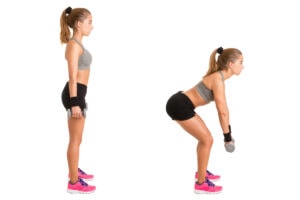Romanian Deadlift is an essential exercise for anyone who strives to build strength in their lower body. Dumbbell Romanian Deadlift effectively strengthens your posterior chain. It targets your legs, glutes, and lower back. For a beginner, learning the proper technique of RDL is essential as it improves your form in other workouts as well.
A Romanian deadlift is a basic workout that you’ll see people doing in every gym. This is a compound exercise for the whole posterior chain. And while the experienced gym-goers usually choose a barbell for the added weight, the beginners perform better with barbells that are generally lighter. Thus, if you are only beginning your healthy fitness journey, a dumbbell RDL would be perfect for you.
What Muscles Are Engaged by Dumbbell RDL?
Romanian deadlift works a great range of muscles, crucial for your overall fitness performance. It engages hamstrings (the biceps femoris, semitendinosus, and the semimembranosus), all three gluteal muscles (minimus, medius, and maximus), as well as erector spinae muscles of your lower back. These are the main muscle groups that are engaged substantially. In addition, secondary muscles activated include your core, trapezius, forearms, and middle back.
Why Is Romanian Deadlift Important?

As time goes, we see the exercise more and more frequently picked up by women due to its strong emphasis on the gluteal muscles. And while you may also be interested in the Romanian deadlift because of its excellent glute engagement, you’ll find many other benefits along the way.
11 Best Dumbbell Exercises for Lats: All Levels
Mastering proper deadlift technique also teaches you biomechanics hip flexion and extension, which is essential for various squat exercises. It teaches you to detach the hip and lumbar movement.
The exercise promotes the strength of deep core stabilizers and their endurance as they are engaged to maintain stability.
How to Master Romanian Deadlift?
- Stand with feet firmly planted shoulder-length apart. Taka dumbbell in each hand using a pronated grip (thumbs down).
- Slightly bend your bed while maintaining a straight spine. Make sure that your chest is up and shoulders pushed back and down. Put your chin down to protect the cervical spine.
- Lower your upper weight towards the floor while maintaining a straight spine. Keep your arms straight. Do you feel the stretch in the hamstrings? Your dumbbells should be somewhere around your knees or shins if you are more flexible. Push your glutes slightly backward.
- Plant the heels firmly to the floor, push the hips slightly forward and pull your back up to the initial position while keeping knees bent. The dumbbells should return to somewhere around the front of your hips.
- Repeat the movement.
Tips
- If you are still a beginner, choose light dumbbell weights that feel comfortable in your hands. A beginner workout – 4 sets of 10-12 reps.
- In time, increase the weights and decrease the numbers of reps. You can switch to this routine: 4 sets of 6-8 reps.
- Do not round your back as you lower. This leads to flexing from the lumbar spine instead of the hips. And can lead to a possible back muscle injury. Engage your core and stabilize your back in the initial position. If the movement is strenuous for you, secure some straight rod along your spine and try the movement without weights.
- Keep the gaze on the floor. If you shift it straight in front, your neck will tilt, which can cause an injury. Remember to protect your cervical spine.
- Keep your knees slightly bent all the way. Find the perfect middle between locking them and bending too much.
- Make sure that you don’t put pressure on the toes, just as in squats. Wiggle them around to check where your weight lies.
- Practice the movements without the added weight first. Learn to perfect your hip flexion and extension control; practice around ten times without dumbbells in front of a mirror to keep a check on your form, especially the spine.
Romanian Deadlift Variations
Barbell RDL

As a beginner, you can opt for a deadlift with only a barbell without added weight. This exercise is just as good as the dumbbell version. As a beginner who works with light weights, you can choose the most comfortable one without losing effectiveness.
How to do:
The technique of this variant is exactly the same and with dumbbells. The only difference is using another type of equipment.
Straight-Legged Deadlift
This variation more repeats the movements of the regular barbell and dumbbell Romanian deadlift. However, just as the name suggests, it is with straight legs with locked knees and lower as much of your flexibility allows.
5 Best Tricep Workouts With Dumbbells
However, it is strongly suggested to leave this variation to professionals who already have complete control over the deadlift technique. As it puts more load on the hamstrings and comes with higher injury risks, this is considered an advanced version of a deadlift.
One-Leg Romanian Deadlift
This variation can be done both with dumbbells and a barbell. It puts all the pressure on one leg and tones each one more effectively.
How to do:
Stand on one leg and slightly bend the knee. Maintain a straight spine; lower your torso and push hips slightly back, just like the regular deadlift. Straighten back, keep the knee slightly bent still. Repeat around ten times and switch the leg. Complete 3-4 sets for each leg.
Overall, a deadlift is a beneficial exercise to include in your leg day training. It targets the posterior chain in a compound movement, thus engaging several muscle groups crucial for your strength and overall physical performance. As you strengthen your hamstring and lower back muscles, you decrease the risk of injuries, power up your hip flexion and extension, and can easily beef up your back lower half.
 Fact checked by
Fact checked by